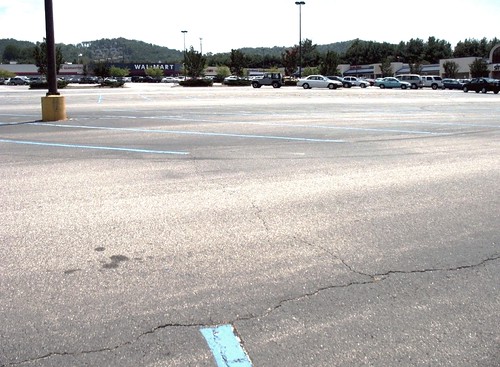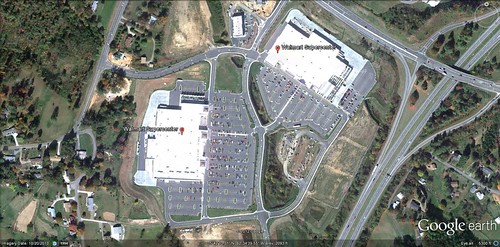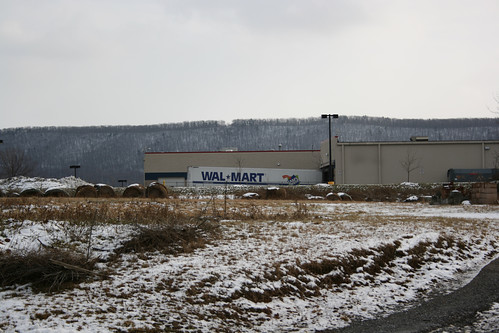Some welcome perspective on Walmart's Sustainability Index

Posted August 2, 2012 at 1:28PM
Architect/thinker Steve Mouzon, whose very interesting perspective on neighborhood walkability was the subject of my article on Monday, is on a roll, and I’m not saying that just because he has become a friend. Yesterday Steve skewered Walmart’s “Sustainability Index,” which has been getting some good press lately. His point: having a sustainability index doesn’t make your business sustainable. I agree.
Before I go on, let me get this out of the way: some very good people, including people I call friends and colleagues, have been working with Walmart to help the company improve its practices. We work with governments and businesses all the time when there are opportunities to make progress, and the perfectly rational argument in favor of this particular one is that, if you care about the environment, you can’t ignore the world’s largest company. To paraphrase Lord Palmerston, we have no permanent friends and no permanent enemies, but only permanent interests. So I will not slam those who are doing what they can inside the belly of the beast.
But, no matter what environmental progress Walmart is able to make on its materials, supply chains, or resource use, the company maintains an underlying business model that in my opinion has been terrible for the environment and terrible for the sustainability of communities. Twenty-acre parking lots that define and extend sprawl, 200,000-square-foot stores that cumulatively generate millions of miles of automobile travel, and literally hundreds of abandoned, massive facilities left behind as community blight will do that. And I’m not even getting into labor practices or impacts on local businesses.
Although the company is moving into urban markets with somewhat smaller stores, that is largely because they have saturated the exurbs and are looking for more places to expand their business. Urban Walmarts carry their own set of issues, but the important point here is that the company’s city stores will be in addition to, not instead of, its tried-and-true sprawl model.
Here’s how the company introduces the Sustainability Index on its website:
“Our customers desire products that are more efficient, last longer and perform better. They want to know the product’s entire lifecycle. They want to know the materials in the product are safe, that it is made well and is produced in a responsible way.
“These desires inspired us to help develop the sustainability index. With this initiative, we are helping create a more transparent supply chain, accelerate the adoption of best practices and drive product innovation and ultimately providing our customers with information they need to assess products’ sustainability.”
Walmart is requiring its “more than 100,000 global suppliers” to assess their own sustainability in a survey; working with a Sustainability Consortium (NRDC is a member), funded by the company and administered by two universities, to “develop a global database of information on products’ lifecycles – from raw materials to disposal”; and developing a tool to bring sustainability information to consumers on products sold in Walmarts. The company says its ultimate goal “is to improve the sustainability performance of the products our customers prefer.”
Those are laudable aims, and consumer disclosure of sustainability information, assuming it’s sound information, could indeed make a difference over time in improving the environmental performance of a wide range of products.
But.
In his post yesterday, Steve applies the principles articulated in his important book Original Green to Walmart’s business practices. He doesn’t mince words:
“Read the 15 questions on WalMart's Sustainability Product Index questionnaire and you'll see that most of them are completely toothless. But that isn't the point of this post. Here’s the point:
“WalMart is essentially doing a tune-up on an engine that is doing more harm than good, from a sustainability standpoint. They’re saying ‘how can we do the same old thing more sustainably?’ But the same old thing pretty much defines the unsustainable.”
Among the particulars, Steve first cites walkability, which is really laughable when it comes to Walmart’s profoundly automobile-dependent model. Moving on, he cites the importance of lovable buildings to sustainable places (the point that first attracted me to Steve’s work), another laughable point for this particular company’s buildings. He then points out that sustainable buildings must be durable, which Walmarts notoriously are not.
Here’s what he has to say about the application of flexibility, another principle from Original Green:
“Sustainable buildings must be Flexible Buildings, so that they can be used for many things over the centuries. But WalMart buildings will never get the chance to be flexible because they’re so famously unlovable. In fairness, they are sometimes converted to muffler shops and pawnshops to extend their lives a decade or two as the neighborhoods around them decay because of the toxic effect of the unlovable and dilapidated big boxes. But who believes that any current WalMart has any chance of standing a century from now?”
Steve does give Walmart credit the company’s efforts at energy efficiency. However:
“But they’re missing much bigger opportunities to be frugal simply because the physical size of the buildings is so large. For example, daylighting and cross-ventilation are two powerful methods for making a more frugal building. But when the nearest exterior wall is a couple hundred feet away, then it’s almost meaningless.”
Steve is hardly the only one taking shots at Walmart, of course. Here’s a bit from the sustainability website care2, in an article headlined “10 Ways Walmart Fails at Sustainability”:
“While Walmart’s sustainability campaign has done wonders for its public image, it has done little for the environment. In fact, Walmart’s environmental impact has only grown over the last seven years. Its business practices remain highly polluting, while its relentless expansion and consolidation of the market have come at the expense of more sustainable enterprises and systems of production and distribution.”
The site faults the company for massive waste generation, failure to match other large retailers such as Kohl’s and Whole Foods on renewable energy, steady expansion of greenhouse gas emissions, and a number of unsustainable food practices. Two points stood out for me, though. The first is that 60 percent of Walmart’s $3.9 million in campaign contributions to members of Congress since 2005 has gone to lawmakers who, according to the League of Conservation Voters, usually vote against the environment. “More than 40 percent of its donations went to lawmakers who vote against the environment at least 80 percent of the time.”
The second standout point concerns Walmart’s truly egregious land use practices:
“Despite its public embrace of sustainability, Walmart continues to maximize its land consumption by building vast, low-rise supercenters. Since 2005, Walmart has added more than 1,100 supercenters in the US, expanding its store footprint by one-third. Most of these stores were built on land that hadn’t been developed before, including, in some cases, critical habitat for threatened and endangered species.
“In many communities, Walmart has chosen to build on virgin land rather than redevelop vacant ‘greyfield’ retail properties. Walmart itself routinely abandons its stores. The US is currently home to about 150 empty Walmart stores, many vacated when the chain opened a newer supercenter nearby . . .
“Yet Walmart’s sustainability program does not address land use at all. Its 2012 Global Responsibility Report doesn’t even mention these very significant environmental issues.” [Emphasis mine.]
I’m glad Walmart is working on its environmental footprint and that of its suppliers. But, when it comes down to it, the scale of its operations may be an insurmountable obstacle. Having a corporate goal of world retail dominance is probably not the best way to be a good citizen for sustainability.
Read Steve Mouzon’s article on Walmart here.
Related posts:
- How to retrofit failing suburban big-box stores into a green showcase (March 12, 2012)
- Walmart goes urban: be careful what we wish for? (September 23, 2010)
- Tax revenue from downtown mixed-use outperforms big-box superstores and malls (July 14, 2010)
- The wild, the innocent, and the Walmart shuffle: we dropped the ball, says the Boss (February 2, 2009)
- Eden Prairie’s new plan irks Walmart (January 22, 2009)
- The Post offers new ideas for obsolete big boxes (November 17, 2008)
- How much parking space does one Wal-Mart need? (August 11, 2008)
Move your cursor over the images for credit information.





